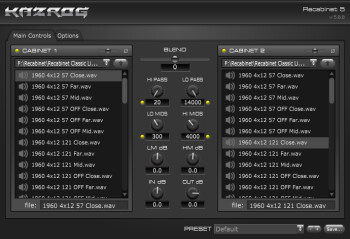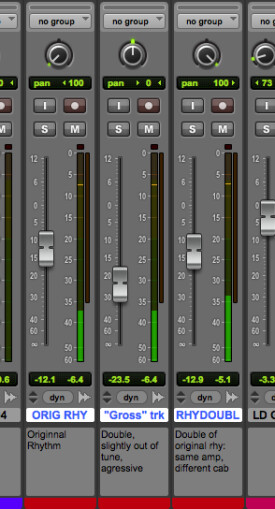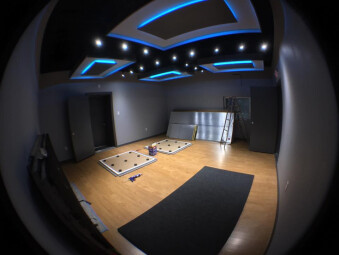Andrew Wade (aka “The Big Boss”) knows a little something about guitar recording. Wade is a producer/engineer/songwriter who has focused heavily on the pop-punk/Emo genres and has produced music (including top-20-charting songs) for artists on many different labels. He’s produced artists such as A Day to Remember, Neck Deep, and The Ghost Inside, among many others. Wade, who’s based out of The Wade Studio in the Orlando, FL area, produces music that’s heavily guitar-oriented. His records feature big thick rhythm guitar sounds, for which he has some pretty interesting methods for capturing and mixing.
He is in the process of building a new studio complex featuring three control rooms two live rooms and four iso booths, all custom configurable depending on the project. In addition, the new studio will include a band apartment, a band practice space, as well as two lobbies, a big entrance, and four bathrooms.

Wade is the guest instructor for the month of May for Nail the Mix, a subscription-based audio mixing program run by producers Joey Sturgis, Eyal Levi and Joel Wanasek. On May 29th, Nail the Mix members will get to see Wade mix the Neck Deep song “Can’t Kick Up The Roots” over a live video feed. Subscribers also have access in advance to stems from that song, so they can do their own mixes.
Our conversation with Andrew focused on his guitar-recording methods, including his creative use of speaker cabinet impulse responses, and his mixing techniques.
I wanted to ask you about the guitar sounds that you get. Especially on the pop-punk stuff, there are always big, fat left and right rhythm guitars. In a nutshell, do you have a formula for how many parts, how many doubles, and how you treat them?
Yeah. Usually, I would do just the left and right guitar. Sometimes it’s cool to have a different cab. It just makes the guitar sound fuller.
So a different cabinet on the left and right parts?
Yeah. Same amp, same settings, but just a different cabinet. But you have to find a cabinet that’s similar. It will never be the same, obviously, but it has to be similar enough of what you’ve had, for it to mix and sound balanced.
I assume most of the guitarists you work with are using 4×12 cabs?
Yes. I don’t know if this will change, but right now I’m all about impulse responses of the guitar cabs. Because that technology, for whatever reason is perfect.
You mean instead of a standard reverb?
No. You’re just capturing an acoustic system. Whether it’s a room or a speaker, you’re capturing a frequency response, and also whatever happens over time with the frequency response over the decay of the signal in that acoustic [environment].
So an impulse response of the cabinet in the room?
Yeah. Let’s say I mike up your typical setup, where I have an amp and a cabinet. I’ll mic it up, make it sound really awesome, and then, when I have it in the right spot, and I really like the way it sounds, I’ll take the amp head out and replace it with a solid state amp — a clean amplifier, not a guitar amp. And then all you have to do is run one sample length of white noise, which literally sounds like a pop, like a static shock. I’ll just run that through the cabinet and record it, and that’s your impulse response.
Then what?
So after that, I will take the sample of the impulse response, and load it into Recabinet. That’s a plug-in that I use. It seems to be stable, it works well and has simple features. You just load it in, and it sounds exactly like the cab. I’ve done blind tests on bands and people who critically listen to things, and no one could hear the difference when it went from the real cab to the fake one.
So you’re triggering that with the DI signal from the guitar?

It’s a little more complicated. I record the DI. Then it goes out of the computer into a reamp box, and then it goes into the amp. But you don’t have to do that, you can go straight to the amp, if you want. But when you have the DI, you can edit it and reamp it. So the first scenario I was talking about with the cabinet, that was just to get the impulse response. After that’s over, say goodbye to that setup, we have the impulse response, and then we set it up differently. We have the DI going into the amp, then into an attenuator into the preamp into the computer. You have to have an attenuator to do this — otherwise you’ll blow your interface or whatever you try to plug your amp into.
So what you’re getting is the sound of the amp, which sounds fucking terrible, it’s just static. But once you throw the impulse response on there, it sounds exactly like the cabinet. So anybody that brings a cabinet in, I’ll make a ton of impulses. I’m eventually going to sell a pack of my impulses.
So what makes this method advantageous vs. just miking a cabinet?
I take a ton of my favorite mics, put them in all of my favorite positions, just keep taking impulse response, and then I’ll sort through them after we’ve recorded the guitar, and I’ll click between them to hear the difference. To me, you can get more creative that way, because it eliminates the time and the physical action of getting up and walking into the other room, moving it, coming back and sitting down, which to me is incredibly distracting. So if you actually have to do that, you’re thinking about everything differently. But if all you have to do is click a button and it’s the other sound, you can more clearly think about what you want and what you’re hearing. Whenever I’m the one moving it, I find that I’m less pleased and less happy about the results.
So it’s basically like the cabinet simulator part of amp modeling software?
It is exactly the same. But I don’t know what a lot of those companies do, but their cabinets sound like shit. That I don’t understand. But if you actually do it right — I don’t know if they’re just doing it wrong, like getting the impulse with the tube amp instead of the solid state amp — but I’m never happy with other impulses besides my own.
Just to clarify something, you only use the solid state amp when you’re capturing the impulse response, right?
Yes. The solid state amp is only to get the pure sound of the cabinet, so there’s no coloration from tubes. Then we take the solid state amp away, goodbye, and then we use the guitar amp.
So DI into your DAW, re-amped into the amplifier, and then that signal with no cabinet is brought into your computer, and then you treat it with the impulse responses.
Exactly. It’s not a typical way to do things, but to me it’s the best way.
Your guitars certainly sound good, you must be doing something right.

The other part of the tone is the fucking player! People don’t understand that. They think they can take any fucking old-string shitty playing and put a tone on it and it should sound a certain way, but that’s not the case at all. If there are several guitarists, each person needs to audition to play guitar. That’s how I do it. If your hand doesn’t sound good, you can’t play.
That must create some interesting situations.
I know how to word it differently. I don’t say it like that. But that’s basically what’s going on.
When when you’re miking up a cabinet, getting ready to capture the impulse responses, do you have a particular favorite way to mic it. I assume you use more than one mic?
Well, recently, I’ve really been liking an [Shure] SM-7, slightly off center. Halfway between the center and the edge of the speaker. The SM-7 sounds pretty cool. 57 is obviously a classic. Another one that I’ve been liking too is the [Sennheiser] 421. I know a lot of other people use it, but for some reason I had never liked it. But since I’ve been using impulses, I’ve liked it. And I think it’s because I’ve eliminated the action of being the one who has to move the mic. “Oh maybe I moved it too much and I fucked it up, ” is the thought that goes through your head.
How close to the cabinet do you usually put the mic?
Just right up to it. I’ve experimented with pulling it back, and it doesn’t really do anything incredible.
And you like to place the mic like you just described, halfway between the center and edge of the speaker?
Yes, because it takes away all the harshness. I’ve tried angling the mic, and using dual mics, but I always end up just taking the other mics away and liking it better. Even though, I used to think that maybe I didn’t like that because it would take multiple tracks. You know what I mean, “Oh, I’m using all those tracks.” But now it’s all in the program, and I can add as many cabinets as I want, but I’m only using one. A lot of people swear by two, but I think the two different cabs left and right might be kind of doing the same thing that two mics do.
So you were talking about the guitar sounds. Same amp, different cabinet impulses.
Same amp, same pedal settings (if I’m using a pedal) but different cab. So the only difference is the cab and the take.
Do you double both the left and right parts?
Not always, but sometimes. I might do it if I want a part to sound really nasty, I’ll do it with like two on the sides. But recently, I’ve been doing one on the left, one on the right, and then a really gross track in the center.
A gross track?
I mean like out of tune, played really hard, with nasty distortion. It really adds a lot to the part.
How much is the center track in the mix, only a little?
It’s quieter than the other guitars, but when it comes in it’s obviously there. And I’ve been using a guitar with an Evertune bridge. Even when you bend the strings, it compensates. You set the tension on the bridge to match the string tension. Each saddle is separate on the bridge. There are springs on the back that give when you pull. So like it’s always in the same position, always at the same tension, because of the springs on the back. You can set it to bend an change pitch if you want, but I usually just grab a different guitar if I want bends. So let’s say I did left and right with an Evertune, which sounds perfectly in tune on the left and right. But then I want the nasty track, I’ll use a different guitar which does not have Evertune. A nasty center track adds a lot of aggression and feeling.
But it’s still rhythmically locked in with the others, but just tonally a little weird?
Yeah.
I wanted to talk about mixing, since that’s one of your specialties. I always like to ask people how they start a mix. What’s the first thing that you do, generally?
Well, I load it all into my template. Everything is organized into busses. Every single track that goes in goes to a bus. Whether it’s keys or drums or effects or whatever.

So each track ends up combined in a bus of some sort. You have a drum bus and a vocal bus, etc.
Yeah, snare, toms go to the drum bus. All the main vocals go to the main vocal bus. Background vocals go to the background vocal bus. But I like to start with the vocals muted and I’ll usually be bouncing back and forth between drums and guitars and I’ll try to get a re-amped sound. I’m usually ending up reamping the guitars when I’m mixing. So, I usually have a setting that I know sounds good, and if it doesn’t sound good than we’re probably in trouble unless it’s like an “interesting” band. But that seems to be rare these days. So I’ll start with that and if the bass doesn’t sound good, also, I’ll have to program it, which is a nightmare.
A MIDI bass?
Yeah, a MIDI bass. Sometimes it will just be the low end that I program, just to clear it up, but you still get the real sounding top end. I’ll put a high-pass filter on the real bass.
But you have to double it exactly if you’re going to do that, no?
No, there’s actually a good bit of room for error there. It could be a little bit offbeat in the mix and you don’t even notice. So, I like to get a good drum and guitar sound, and vocals are like dead last.
When you pan the rhythm guitars, are they usually hard left and right, or are they in a little bit in?
Usually hard left and right. But let’s say there’s a part where it’s just a guitar. I may throw on super light room reverb in stereo. So say if the guitar is completely right, to the left it will sound like it’s being played in a room. If you have headphones on, it will sound like it’s being played in the room with you, kind of. If you don’t have headphones on, you’ll never notice the reverb.
How long does it usually take you to mix a song?
I’ve been getting pretty quick at it. The initial song, when I’m mixing an album, will easily take a day. If I’m having a hard time, it might take me a day and a half. If I get burnt out at the end of the day. I’ll just stop listening, and the next day it will be way easier to make choices. The first song will take that long, but the rest of the songs, I’ll fly through. I’ve done full albums in just a few days.
Because they’re all recorded the same way, so the first song is like a template for the rest?
Hopefully. Sometimes not.
What do you use for monitors?
Right now I’m using the BM 6A Mark II’s by Dynaudio. But the new studio is a lot better acoustical environment than usual. Better than what I’m used to, because basically, wherever I’ve been living is where the studio has been. But it’s such like a, I guess well-rounded mixing environment. The sub is not like boomy, the way it normally is in a regular room, because it’s just bouncing off all the walls and there are no bass traps. But we have massive bass traps all around where the monitoring environment is. I may be changing monitors, I don’t know. The room’s bigger, the studio’s bigger. For everything that’s here, we’re thinking bigger.
Do you typically switch between different types of monitors when you’re mixing? Do you have any ways that you hear mixes differently than just sitting in the mix position?
That’s a good question. For a while — and I don’t really do this anymore — I would stand up, because it completely changes the high end.
Your ears are above the tweeters, then.
Yeah. And everything sounds different. It’s good for it to sound different. It’s good for it to just be in different positions in the room. What I’ve normally done is use whatever monitors I have, some decent headphones that I’m familiar with, and my car. But there are a few tricks to make more with what you have. On my master, sometimes I’ll literally just take the high end and jack it up, like crazy, and see if the high end still sounds smooth. And if it does, I’ve done a good job. But if anything is poking out, then I need to take that back.
At what frequency do you boost at?
Say from 4kHz up. Jack it up, listen to it like that. And I’m telling you it reveals so many things you didn’t notice before.
In other words, elements that aren’t blended in the mix that well are going to jump out when you do that.

Right, because say if you’re mixing and everything is a little bit warm, sometimes something may be way more trebly on other systems, but you wouldn’t know that unless you really listened to all the treble. So I’ll do that. I’ll do the same thing with the low end, where I’ll just filter out all the high end, making sure everything still sounds punchy and clear without the high end.
What frequency range do you use for that filtering?
I would say cut it off at 1kHz.
That’s an interesting technique.
It has really helped me a lot.
Any other tricks like that?
The sub to me is key. Before I had a sub, I don’t know how I survived. But just monitoring stuff on my sub is such a big deal. There’s low end in the vocals that you didn’t even know was there. There’s stuff in the vocals that you will not hear unless you have a sub. It’s something that I’ve gotten recently within the last five or six years. To me, that’s a really big deal, too.
Before the sub, did you do a lot of high-pass filtering to take out those unneeded low frequencies.
Yeah, but it’s easy to go overboard. If you have a sub, you take out only what you need to take out and you’re done. It doesn’t need to be crazy.
Tell me about what you’re doing for Nail the Mix?
That’s going to be awesome. I think what Joey [Sturgis] and Ayal [Levi] are doing is pretty awesome. I don’t know if you know how it works?
I know it’s an online mixing clinic, and when you sign up you get stems.
You get all the mix files from the session. It’s incredible that the band and label are on board with this. They’re doing this with a ton of bands. These are big established bands. The band that I’m mixing is Neck Deep. They’re doing quite well, put it that way. I’ll be showing all my presets. And it’s all in-the-box stuff, so you can literally copy the presets exactly, and do your best to make it sound good. Obviously I’m not going to go through every single track. But it will definitely be eye opening, especially for the bedroom producers, because that mix is completely in the box.
Thanks very much and good luck with the new studio.
Thank you.


